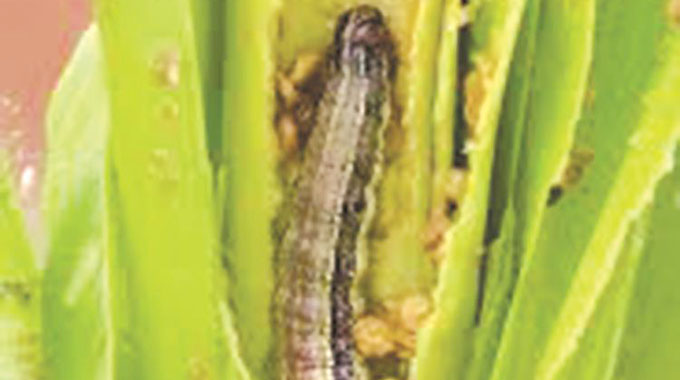Source: Plotting downfall of the armyworm | The Herald October 9, 2019

Sifelani Tsiko Agric, Environment & Innovations Editor
Government should step up the training of extension workers and farmers across the country to help contain and manage fall armyworm outbreaks in the 2019-2020 cropping season, agricultural experts say.
Head of the University of Zimbabwe’s Department of Soil Science and Agricultural Engineering Professor Brighton Mvumi told The Herald on the sidelines of a public lecture on identification, control and management of the fall armyworm, that Government should continue to undertake several training programmes to raise awareness among extension workers and farmers.
“There is still a lot of confusion about identification and we need more refresher courses for our extension workers and more training programmes for our farmers,” he said.
“Farmers need to be trained consistently on identification of the fall armyworm as distinguished from other moth species. Extension workers and farmers in all provinces should get the correct messages to ensure that farmers are able to scout early their crops even at vegetative and productive stages.
“Training is critical and crop disease management is a very dynamic field. We must help to end confusion about identification of the fall armyworm and promote strategies that could minimise losses of our crop.”
Entomologist and former Iowa State University crop expert Prof Marlin Rice presented a public lecture on identification, control and management of fall armyworm at the University of Zimbabwe this week.
He spoke at length about the main characteristics of this voracious pest that is threatening global food security and recommended integrated pest management strategies to tackle it.
“This voracious insects eats almost anything — some 352 plant species in 76 families. It is a worldwide devastating agricultural pest that has moved from South America, the US, West Africa before it spread to all sub– Saharan African countries and Asia,” he said.
“The species looks like many other species and it’s very difficult to identify it. Assisted by strong winds, it is capable of flying 250km in one night and up to 485km over several nights. We need to identify it correctly and adopt integrated pest management strategies to fight it.”
Prof Rice, who is now a Corteva Agriscience technical expert, said the effective containment and management of the fall armyworm required multiple approaches that include early surveillance and detection, monitoring and scouting, early crop planting, elimination of weeds and avoiding inter-cropping maize with pumpkin.
“We should target to kill the fall armyworm when they are small than when they are big,” he said. “In addition to this, we should consider rational and responsible use of selected and approved insecticides to avert a lot of losses.”
Government has for the last few years offered training to its extension workers and farmers across the country to increase resilience and enhance production even under increasing threats from the fall armyworm.
A plague of fall armyworm has spread to all the country’s provinces, at one point, infesting nearly 150 000 hectares posing a serious threat to the country’s major staple food crop — maize.
The Food and Agriculture Organisation estimate (FAO) has supported Zimbabwe to initiate awareness programmes that inform and train farmers on integrated pest management techniques.
These included identifying natural enemies of the fall armyworm, enhancing natural biological controls and mechanical controls.
Most farmers are using chemical pesticides to fight the pest, something which has increased their production costs as well as causing negative effects on environment and public health.
“The use of biotechnology is still controversial here in Zimbabwe and most other African countries,” said Prof Rice. “I know it’s not allowed here, but you have to explore this. Biotechnology is not the only answer but it could be one of the options to fight the pest.
“Africans are consuming genetically modified maize but they don’t want to grow it. It’s still banned and there has to be some debate on this frontier as you search for options to tackle the fall armyworm.”
However, Prof Mvumi raised concerns over food safety and environmental concerns saying these had to be addressed first before the country could harness biotechnology to fight the fall armyworm.
“Biotechnology is a very controversial matter,” he said. “People are still concerned about the safety of GMO maize. We have to conduct proper analysis before we can use it here to fight the fall armyworm and other pests.”
FAO estimates that the pest has caused economic damage that ranges between US$1 billion to US$3 billion on the entire African continent.
The first report of the fall armyworm in Zimbabwe was in 2016 when the pest was detected in the Bubi district of Matabeleland North province.
The fall armyworm pest was first reported in Africa in 2016. Native to the Americas, the fall armyworm can feed on 80 different crop species, including maize — Africa’s major staple food consumed by more than 300 million on the continent.
COMMENTS